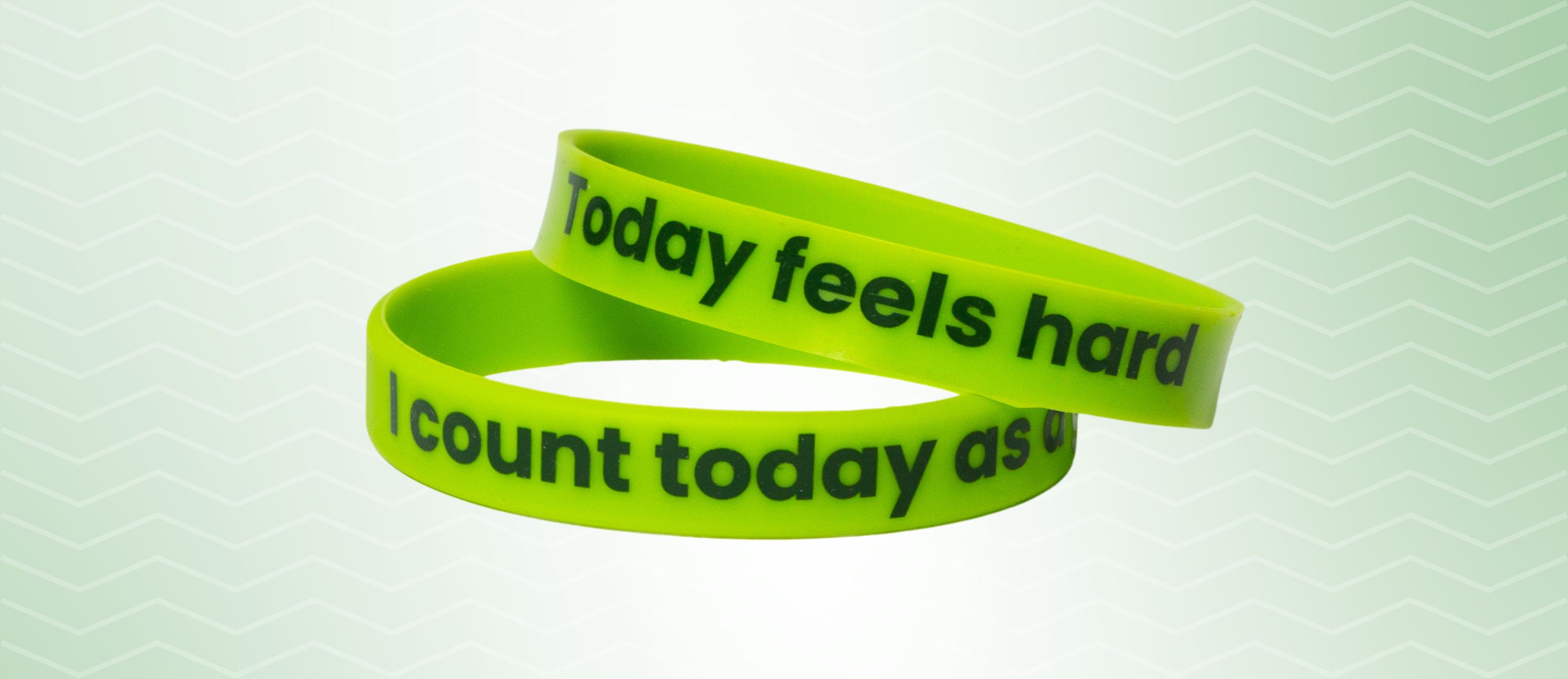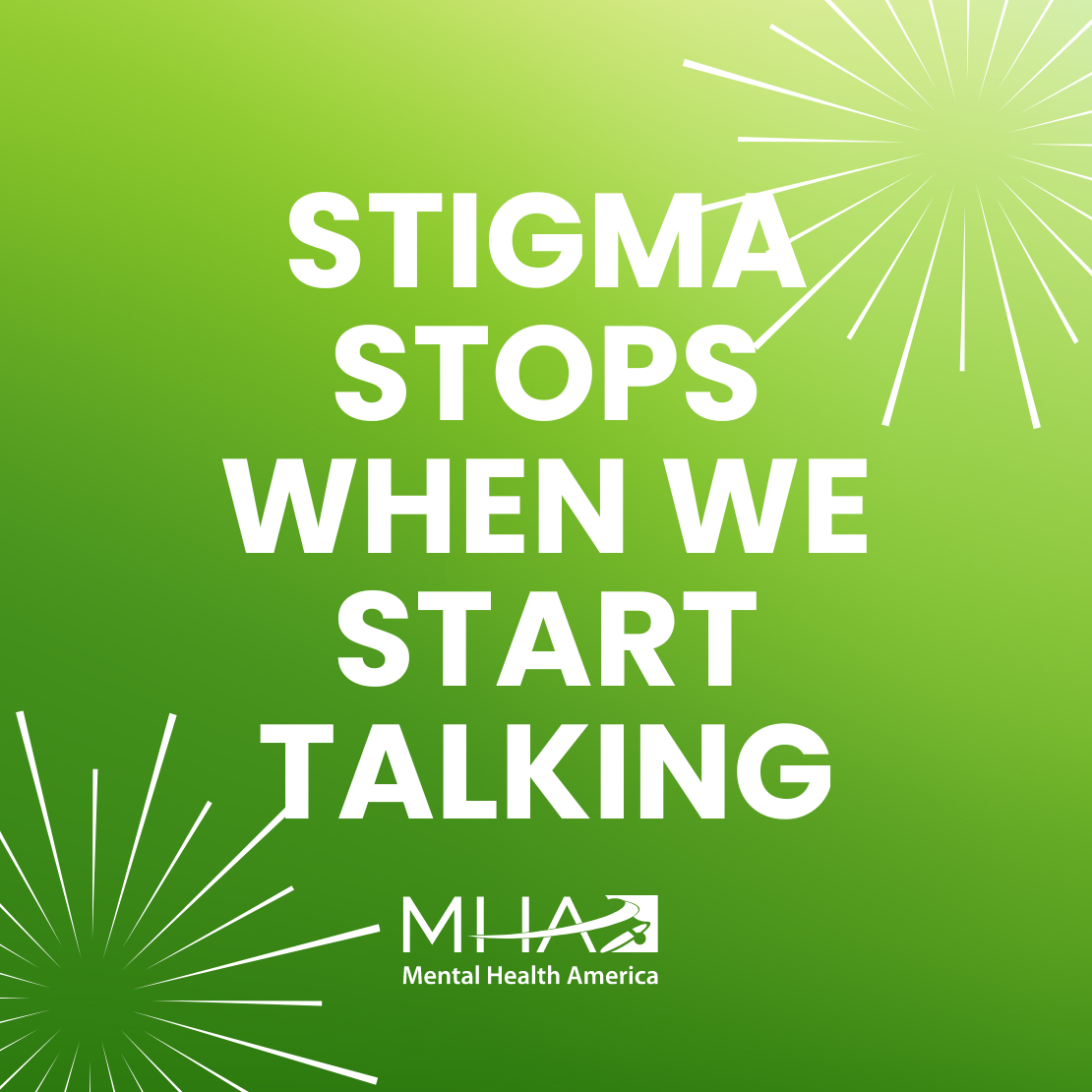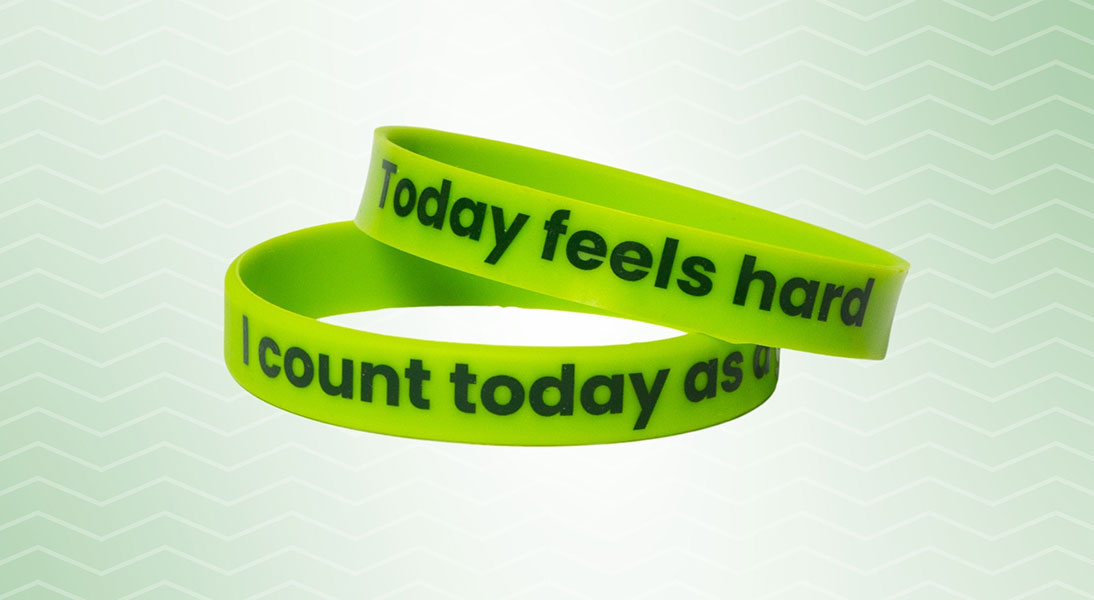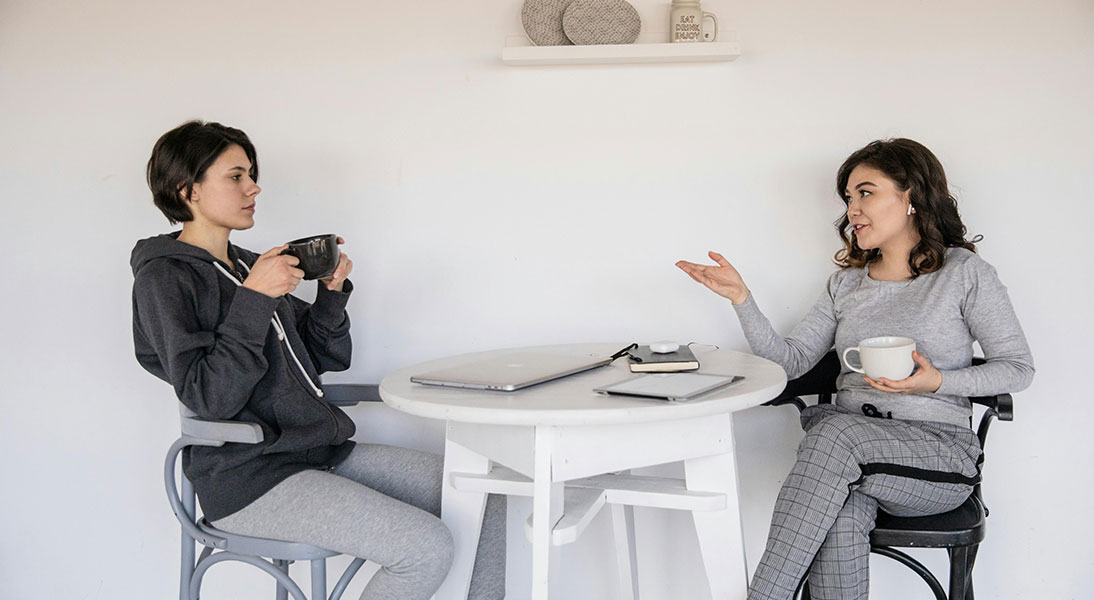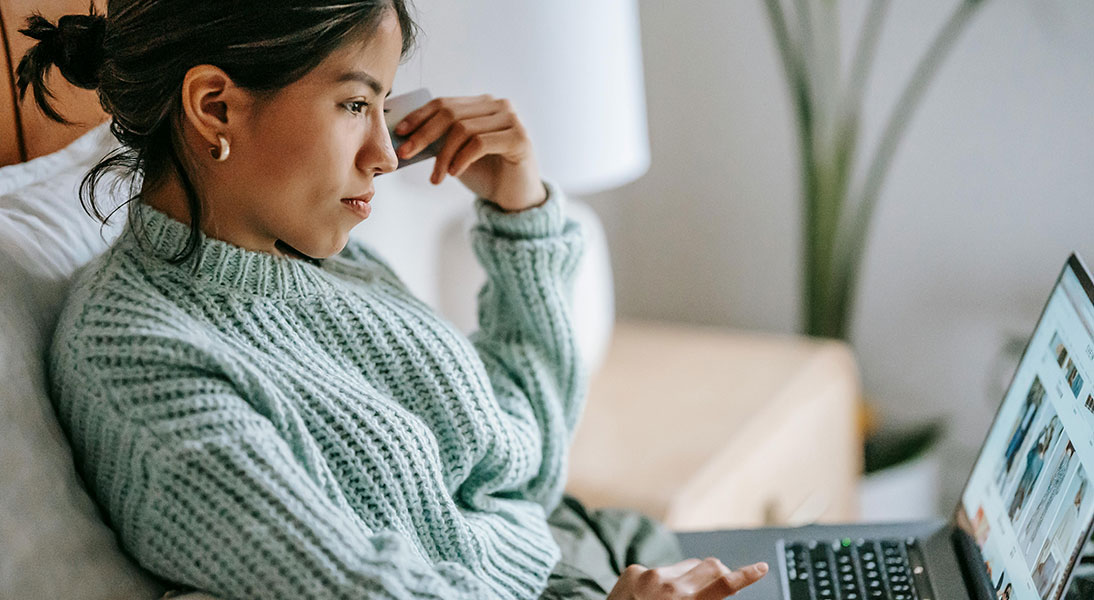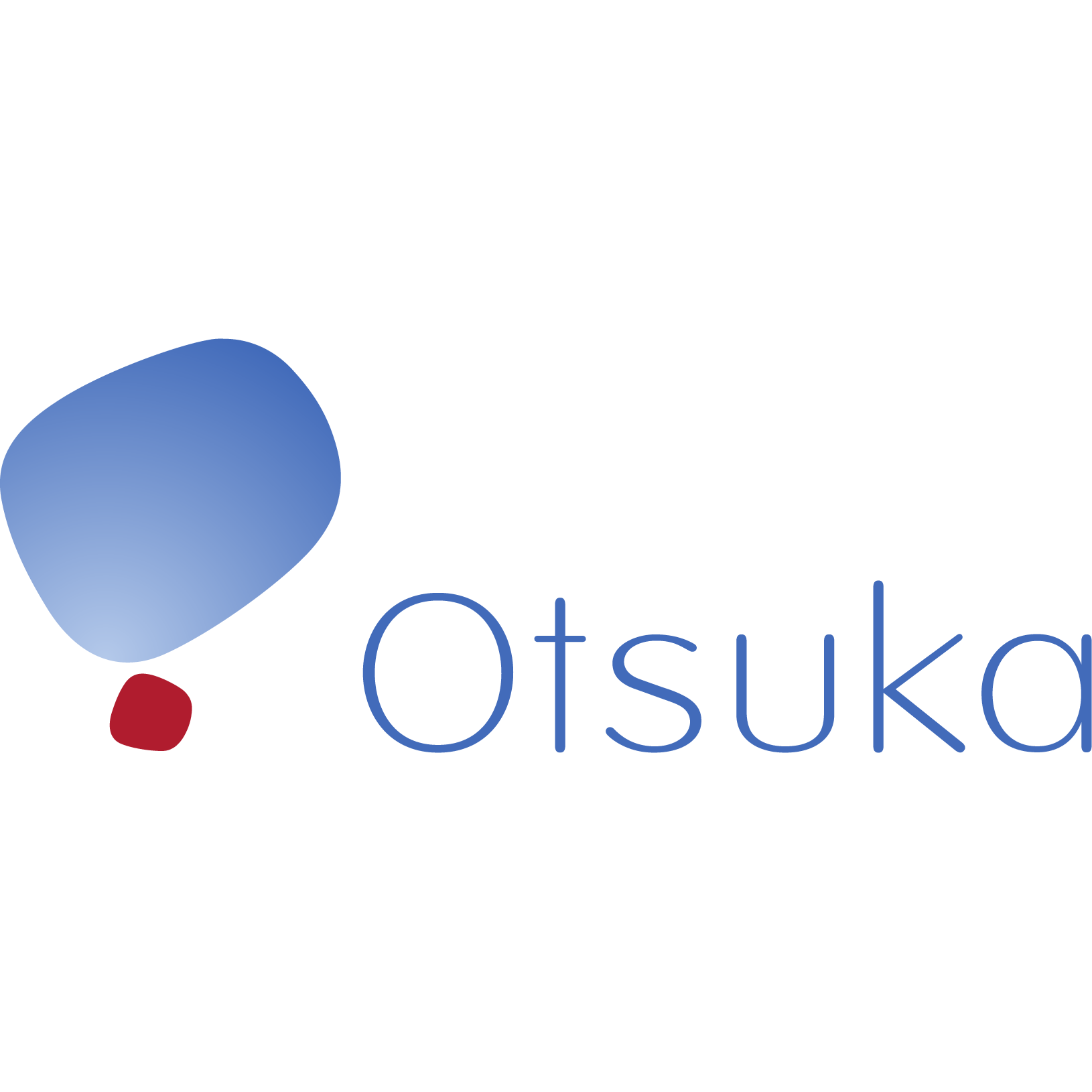Stigma Stops When We Start Talking
Wear and share
Welcome to our Mental Health Awareness Bracelet Campaign, where we strive to break down the barriers of stigma surrounding mental health one wrist at a time. Our initiative centers around a simple yet powerful accessory: a bracelet with dual-sided messages, "Today feels hard" and "I count today as a good day."
Designed to serve as both a personal check-in tool and a visible symbol to others, this bracelet encourages wearers to reflect on their mental well-being daily and promotes open conversations about mental health. It sends the message that it is okay to feel what you feel.
The goal of this campaign is to help spark conversations about mental health and contribute to a larger movement of acceptance, empathy, understanding, and support for mental health challenges.
Join us in starting a meaningful dialogue and fostering a community where mental health is embraced without judgment!
"I was devastated to learn we lose someone to suicide every 40 seconds. It made me wonder how many lives could be saved if asking for help was easier. That sparked an idea - a two-sided bracelet that could be flipped to silently signal when someone was going through a difficult time. For me, the bracelet has been life-changing - reducing the stigma of asking for support and starting conversations about my mental health that would not have otherwise happened.
My hope is this simple tool allows others to prioritize their mental health and break down barriers that too often prevent people from reaching out. By normalizing the conversation around mental health, we can create a world where no one struggles alone."
— Juliet Serrato
Join the Wear and Share campaign
Here's how you can participate
Get your bracelet
Thanks to support from Otsuka America Pharmaceutical, Inc., the first 25,000 bracelets were offered for free! They are now available for purchase at the Mental Health America store.
Wear your bracelet
Put your bracelet on and wear it daily as a personal reminder to check in on your mental well-being. Let it serve as a visible symbol of your commitment to mental health awareness and destigmatization.
Share your journey
Share your experiences wearing the bracelet on social media and tag @mentalhealthamerica. Post photos, videos, or written reflections discussing how the bracelet has impacted your mental health journey or how it has sparked conversations with others.
Encourage others to join
Spread the word about the campaign and encourage your friends, colleagues, family, and community members to join the campaign by ordering their own bracelet or sharing one from your 2-pack. Let them know how they can get involved and the positive impact they can make by wearing and sharing their bracelets.
Support each other
Throughout Mental Health Month and beyond, support each other in your mental health journeys. Use the bracelet as a conversation starter to check in with friends, colleagues, and loved ones about how they're feeling and offer support and encouragement. Visit our "Finding Help" resources page for more information on your own mental health or to learn how to offer support to others.
Be an ambassador
Consider creating an event around the Mental Health Awareness Bracelet at your office, book club, school group, or other community gathering. This can be a powerful way to engage your community and spread awareness about mental health. For tips on how to turn your event into both an awareness event and fundraiser, check out this brief step-by-step guide.
Turn hope into help. Consider creating your own awareness fundraiser to show your commitment to mental health awareness or explore other ways to give.
How to use the bracelet for yourself
The bracelet is a great way to be intentional about checking in on your own mental health. If you start to see that there are a lot of hard days, consider talking to someone, taking a mental health screen, or visiting MHA's "Finding Help" resource page.
Here are simple steps to use the bracelet.
Each morning, take a moment to check in with yourself and reflect on how you're feeling emotionally. Consider factors such as your mood, stress level, and overall well-being.
Based on how you're feeling, choose the side of the bracelet that best represents your emotional state at the moment:
If you're struggling and feeling like the day is particularly challenging so far, flip the bracelet to the side that says, "Today feels hard."
- Remember, you define what “challenging” or “hard” may look like. This is your journey. Our hope is that sharing your experience that day may help to create a more empathetic environment that makes the challenging day feel more manageable. We also hope your vulnerability may help validate other’s experiences when they may not feel comfortable sharing theirs.
If you're feeling hopeful or encouraged and acknowledging the day as a good day, flip the bracelet to the side that says, "I count today as a good day."
- Keep in mind that you determine the definition of a “good” day and that it will vary for each of us. Your sharing creates space for open mental health conversations and may help others realize that connecting with others can make tough times feel a little lighter. Embracing a positive outlook isn't just about hope; it's a crucial factor in improving our mental well-being.
*If there's a day when you don't feel comfortable or safe sharing, it might be a day you choose not to wear the bracelet. But you have done the hard work — checking in with yourself and acknowledging your feelings.
Wear the bracelet with your chosen message facing outward throughout the day. This serves as a visual reminder to yourself of your current emotional state and signals to others how you are showing up that day.
As you go about your day, periodically check in with yourself and reflect on how you're feeling. Use the bracelet as a tool to stay mindful of your emotions and to remind yourself that it's okay to feel what you feel.
Before bed, take another moment to reflect on your day and how your emotions may have shifted. If there has been a change, adjust the bracelet to reflect any changes in your emotional state.
Continue this daily ritual of checking in with yourself, choosing a side of the bracelet, and wearing it as a reminder of your emotional journey.
By following these steps, you can effectively use the Mental Health Awareness Bracelet as a tool for self-reflection, emotional awareness, and stigma reduction. Remember that it's okay to have difficult days, and reaching out for support when needed is a sign of strength, not weakness.
How to support someone using the bracelet
When encountering someone wearing a Mental Health Awareness Bracelet, it's essential to recognize that the bracelet serves as a powerful tool for initiating conversation about mental health. The individual wearing it is signaling their current emotional state, inviting others to engage with them in a supportive manner, or helping to reduce stigma about mental health by wearing the bracelet. It's important to understand that as the observer, you don't need to feel burdened by having all the right answers or solutions. Instead, view this as an opportunity to show empathy and, where you feel comfortable, offer genuine support and validation. Remember, it's okay if you don't have the capacity to engage deeply with the individual at that moment. Simply acknowledging their experience and offering a listening ear can make a significant difference.
Here are some ways you can support someone wearing the bracelet.
If you see someone wearing the bracelet, be attentive to the message displayed. Even the small gesture of noticing and acknowledging the bracelet can help the person feel seen. Show that you're attentive and are open to conversation.
Recognize the person's feelings by acknowledging them and affirming that it's okay to feel the way they do. Avoid judgment or minimizing their emotions. If you aren’t able to dedicate time to the individual or have a conversation, even a passing comment, like, “Today feels hard for me too,” or “Thanks for the reminder to count today as a good day,” can be validating and can make a significant difference in the day.
If you have the emotional capacity and time that day, ask open-ended questions to engage in a conversation. Approach the individual with empathy and sensitivity, acknowledging that wearing the bracelet may signify a need for support or recognition of their emotional state. If appropriate, ask gentle questions to validate the individual's experience and show that you're interested in understanding how they're feeling.
Respect the individual's boundaries and comfort level. Understand that they may not always want to engage in conversation or share their experiences, and that's okay. Keep in mind that how much an individual may share with you will depend on a variety of factors, like how well you know the person, the environment (e.g., work, school, at home), or their emotional capacity that day.
If you don't have the capacity to engage with the individual at that moment, it's okay to acknowledge that. Your emotional well-being is as important as the individual’s. Ask about other ways you can offer support, including simply being a supportive presence, being someone they can call on to join in self-care activities, or offering to accompany them in seeking help. Remember, the type of support will vary for the individual.
By following these steps, you can provide meaningful support to individuals wearing Mental Health Awareness Bracelets, helping them feel seen, valued, and supported in their journey toward mental well-being. Remember that being open-minded and offering a listening ear can make a significant difference in someone's life.
If you or someone you know is struggling or in crisis, help is available. Call or text 988 or chat 988lifeline.org. You can also reach Crisis Text Line by texting HELLO to 741741.
This campaign is supported through the contribution of Otsuka America Pharmaceutical, Inc.


